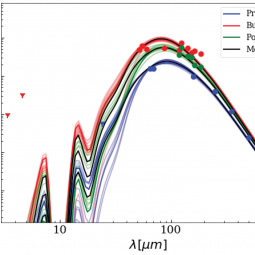By Joan Schmelz and James Jackson
Paper:
Infrared observations of the flaring maser source G358.93-0.03. SOFIA confirms an accretion burst from a massive young stellar object
Stecklum, B., et al., 2021/02, A&A, 646A, A161.
Theory has long suggested that the mass growth of protostars occurs stochastically in a series of episodic accretion events from the surrounding disk. Until the central protostar dominates the total mass of the system, the surrounding cool disk is highly susceptible to gravitational instabilities, resulting in stochastic accretion of clumpy disk components onto the protostar. During an accretion event, the luminosity of the protostar increases rapidly due to the conversion of gravitational energy to thermal radiation. Quantitative observational research on stochastic accretion has just begun, especially for high-mass stars.
A detailed study of massive young stellar objects is hindered by the large quantity of surrounding gas and dust, but infrared observations can penetrate these dense envelopes. Because the radiation generated from an accretion event emerges mainly in the mid- and far-infrared, SOFIA data are crucial for deriving the total luminosity of the young star and the fundamental parameters of the accretion burst. Since these massive young stellar objects are rare and their growth phases last only a small fraction of their lives, scientists need either very good luck or a successful search strategy to observe these events.
Methanol masers are signposts of massive young stellar objects. Recent evidence shows that flares of these masers are driven by accretion bursts. Thus, maser monitoring can be used to identify such bursts, which are otherwise hard to discover. Infrared observations reveal burst-induced changes in their spectral energy distribution, which provide valuable information on this intense phase of high-mass star formation.
In mid-January 2019, maser flaring was reported of the massive young star called G358. The international maser community initiated an extensive observational campaign that revealed extraordinary maser activity and yielded the detection of numerous new maser transitions.
Since these bursts of brightness from growing young stars are mainly visible in the far-infrared, observations were obtained from the Far Infrared Field-Imaging Line Spectrometer (FIFI-LS) instrument on SOFIA. Integral-field spectroscopy was carried out to detect possible counterparts of the maser sources and compare their photometry to archival measurements. The comparison of pre-burst and burst spectral energy distributions confirmed the increase in brightness as well as the subsequent slow decay. During the growth spurt, the source emitted about five times more energy than in the quiescent state.
The infrared data obtained by SOFIA were crucial in deriving fundamental parameters of the accretion burst such as the mass accreted during the event and the total energy released by the burst. Radiative transfer modeling yielded major burst parameters and suggests that the circumstellar disk may be transient. The significant changes to the spectral energy distribution in the infrared also allowed astronomers to exclude other physical processes, such as varying obscuration, that might be responsible for the luminosity variations.
SOFIA also detected a similar but less luminous accretion event in the low-mass star FU Orionis as well as a high-luminosity accretion event in S255IR. Observations of S255IR, a protostar of 20 solar masses, established both the mass accreted (~2 Jupiter masses) and the energy released (~1046 erg) during the burst, three orders of magnitude higher than any previously observed accretion event from lower mass stars. Presumably such accretion bursts, while rare for an individual object, often occur somewhere, due to the large number of protostars in this phase. Accurate measurements of the accreted mass and the luminosity of future stochastic accretion events would not be possible without SOFIA.
The verification of the accretion burst from G358 is another confirmation that methanol maser flares provide reliable alerts for such events. Thus, monitoring of these masers greatly enhances the chances of identifying massive young stellar objects during periods of intense growth. The few events known to date already indicate a broad range in burst strength and duration as well as environmental characteristics.
These results substantiate the predictions of disk fragmentation models and radiation hydrodynamic simulations while ruling out alternatives like stellar mergers. The data also confirm that high-mass stars may form like their less massive siblings, namely from collapsing interstellar gas and dust clouds, ultimately gathering the in-falling material in an accretion disk. Moreover, the new observations provide strong evidence of episodic accretion in young massive stars. Since the matter distribution in the accretion disk appears to be clumpy rather than continuous, disk fragments are occasionally ingested onto the growing star, causing eruptions. These new findings confirm that the formation of high-mass stars can be considered a scaled up version of the process by which low-mass stars like our Sun are born. The main differences are that massive stars would form with larger disks, higher accretion rates, and on much shorter time-scales (around 100,000 years instead of several million years).

